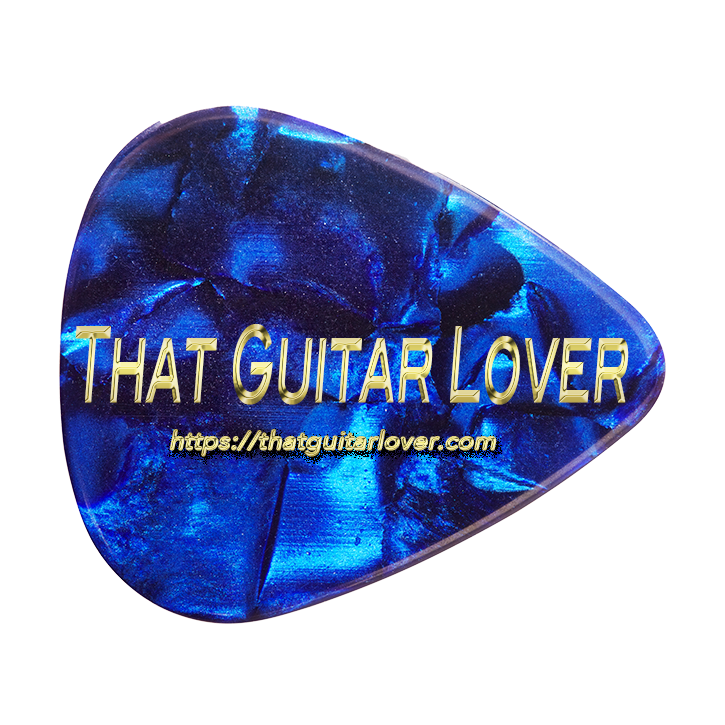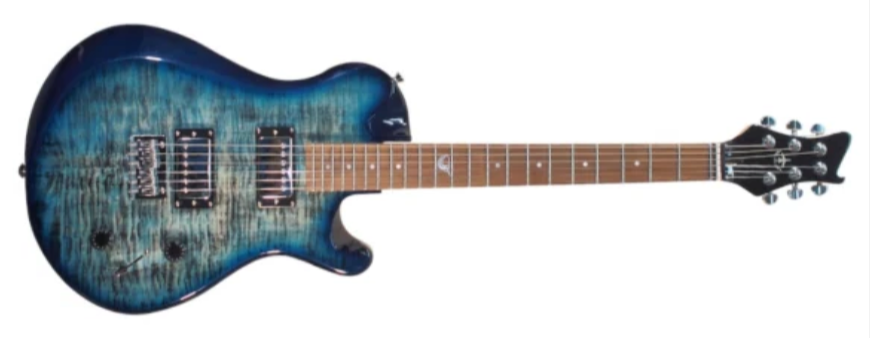Review : Journey Instruments OE990 Overhead Travel Electric Guitar
Hello and welcome to the third and final for the moment review of Journey Instruments Travel Guitars. This time I am working with the electric six string version, although Journey Instruments does also make bass guitars. The OE990 family is available in three colours, a faded blue, a faded black and a dark cherry sunburst. The pricing is the same for all colours at $787.99 CAD MAP.
Overview
The guitar as you can see from the images provided, is a Single Cutaway shape with a poplar body and maple top. The neck is a U carve maple neck with either a rosewood or composite fingerboard and dual carbon reinforcement rods in addition to the adjustable truss rod. The body is beveled in the back, the arm and the cutaway for comfort and ease of playing into the upper frets. The finish is a high. gloss poly but matte on the back of the neck for smoothness and no stickiness. Scale length is 25 inches with 22 nickel / brass frets. The guitar weighs in quite light at 7.6 pounds. The tuners are Journey’s own 18:1 locking units. The electronics are a pair of humbuckers and a master volume and master tone control. A push pull enables the splitting of the humbuckers. The nut is bone and the bridge is a steel hardtail with string through body design. The factory strings are tens
As can be seen in the opening image, the neck uses Journey’s patented and capable system to release the neck for packing in the included travel case when moving the guitar around. This means that when folded and in the case the entire package is only 20.5” x 13.4” x 7.4” and total weight of 11.5 pounds. Unlike the acoustic models, the headstock is separate from the neck and it mounts via a pair of metal pins into holes in the end of the neck. When mounted and the neck attached to the body, the seams are not noticeable. You will also notice in the images above that this instrument features a zero fret which makes enormous sense seeing as the headstock is detached for travel in the provided case.
The case for this guitar is different from the ones for the acoustics. This should not be a surprise. Fit and finish are still very good, the difference being that the body and the headstock are in the rear compartment and the neck is stored in a slipcase inside the front compartment. There is still space for a laptop and room for your typical accessories such as tuner and strap. It’s really fitted out as a backpack and fits well, even if your body is larger.
Playability
As with the other two Journey Instrument guitars reviewed already, set up is a breeze as is takedown. To assemble the electric version, attach the headstock, then put the neck in the slot and connect the locking bolt and tighten it up. I take my time tightening the neck up and find that it goes easier than doing it quickly. Once you are sure the neck is locked in place, which is easily verified by the bolt and checking the action, tune the strings up. As with the other guitars, as they were all new, a string stretching was required initially. Once stretched in, the strings hold tune quite well. I believe that the factory strings are Elixir Nanos, not bad but certainly not my personal preference, but good enough to be going on with. With the neck attached, the factory action was excellent.
The U carve doesn’t feel as chunky as some U carves do and I found it quite comfortable. I personally prefer wood fretboards over composites but that is purely me as the carbon fibre fingerboard on the carbon fibre acoustic is great. I am not sure what composite means in this case, possibly something like the Richlite we see on so many other guitars. The fret work is very good with no rockers and the fret ends are not sharp. It is my personal preference to polish the frets on new guitars that I purchase. I did not do so in this case, because I wanted to maintain the experience of the new owner.
The volume knob is reasonably close to the bridge pickup although I would like it a bit closer because of my affection for volume swells and having shorter fingers. The pots are very smooth and the push push on the tone control is positive. It really is a push switch and locks in the down position for humbucking, press it and it releases to the up position for the coil split sound.. The three way pickup selector is a slotted style switch and worked well with no noise at all, more PRS than Gibson positioned. In actuality the body is more reminiscent to me of a PRS single cut to a Les Paul. The weight, the bevels and the design being very comfortable to play whether seated or standing. The strap lugs are decent, although I would add rubber lock on washers as is my personal choice as I always use a strap, lest I receive another demonstration on gravity and its impact on guitars without straps.
The colour has nothing to do with the playability. Journey Instruments calls the black one black, but I chose to call it a black fade as that is what it looks like to me. It certainly is not a solid deep black and in my opinion this colour gives more depth and reveals the look of the maple cap better. My personal favourite is the blue and looking about the studio, it’s clear I may have a bias down this road as the Journey is not alone in its colourway. The cherry sunburst is the colour of my evaluation instrument and it is as dark as it appears in the photograph, always a cherry red with no oranges or yellows as is often inferred by the phrase cherry sunburst. The photo also doesn’t do justice to the bright chrome finish of the pickup covers.
When I first played the guitar, unplugged as I usually do, I was honestly quite surprised by the volume and resonance of the acoustic tone.
The Pickups
The two humbucking pickups set up arrived with them very low and to my ear, very bassy. Warm but too dark, almost muddy. I raised them up as high as I could without impacting strings at the high frets then dropped the bass sides about a turn and a half to get a tone more pleasing to me. The single/humbucking switching took me a bit to get used to being most accustomed to push / pulls but once I became acclimated, it’s quite effective. My learning curve really related to doing a full push instead of a tap to actuate the switch.
In my first play test, I found the tone over bassy and somewhat muddy. Tone is super subjective and this is not the first time I have wanted more high end. Perhaps it is because I can still hear to 14Khz that I find something missing. When you kick in an overdrive pedal or use an overdriven amp, that becomes less of an issue for me, but I always test first unplugged, then into a very clean amp because it is my perspective that doing so tells the most accurate story of the pickups, even when they are wound for overdrive. Even in single coil configuration, the instrument is still quiet when not being played. As one would expect, the output drops when you switch to single coil mode.
That changed when i switched to the Universal Audio Amplifier pedals. Then the pickups sounded, in my opinion, really good. The combination of the pickups and the world’s best, again my opinion, amplifier emulation was superb.
Recorded Examples
To make the recorded examples, I used Universal Audio amplifier emulators. The Dream 65 was used for a clean tone, the Lion 68 for a classic rock tone, and the Knuckles 92 for those desiring a metal tone. My opinion is that the guitar as it comes can work for any genre once you have your full signal chain in place. I chose these amplifier emulators because I know them well and I use them in the studio a lot, certainly more often than miking a physical amp or using an amplifier plugin. You do what works best for you. I recorded directly into Logic Pro and resisted the temptation to add plugins that might take away from the real sound of the guitar.
For those unfamiliar with Universal Audio Amplifer pedals, the Dream 65 emulates a 1965 Fender Deluxe Reverb, the Lion 68 emulates a 1968 Marshall Super Lead and the Knuckles 92 emulates a 1992 Mesa Boogie Dual Rectifier.
The sample has three sections, one for each amplifier. Each amplifier has two sections, but the High Gain Knuckles has a third. The first is just an A chord played three times in the humbucker setting for each switch setting, bridge, middle, neck, then repeated with the guitar in single coil mode. This is followed by a very basic chord riff. In the Dream 65, the pickups were in humbucker mode, the switch in the middle position. For both the Lion 68 and the Knuckles 92 the pickups were in humbucker mode and the switch in the bridge position. The third section of the Knuckles is just a really short note riff to give a sense of metal amp sustain.
Wrapping Up
In my review of the wood bodied acoustic, I posited that placing the guitar in the travel guitar box may be doing it a disservice. Certainly this and the others are built for travel, but having spent time with all of them now, I would not relegate them to travel only as a general thing. The wood bodied acoustic could easily be your only guitar but some might find the carbon fibre version a bit quiet. I am less comfortable making such a statement about the electric version not because it fails at anything, but because in terms of return on spend, its real standout feature is its travel capability in reduced space. From a playability and sound perspective, I did not find it superior to less expensive electric offerings such as those from Yamaha or Squier. While the data suggests that travel instruments are more often acoustic because acoustic players are more comfortable taking just a guitar with them than electric players, I would be perfectly happy travelling with the electric version and a copy of TONEX on my iPad along with the simple IKMultimedia interface. You can also just play it acoustically if you are ok without amps and effects. I am, and always do my first play test on any electric with it not plugged in. An electric that sounds dead without an amp is always louder but still dead when plugged in.
If you like what I do here for you, please become a supporter on Patreon. Your monthly contribution makes an enormous difference and helps me keep things going. To become a Patreon Patron, just click the link or the button below. Always feel comfortable to send in a question or to post a comment. I read them all and respond as appropriate. Thanks for your support of my work. I’m Ross Chevalier and I look forward to sharing with you again soon.




